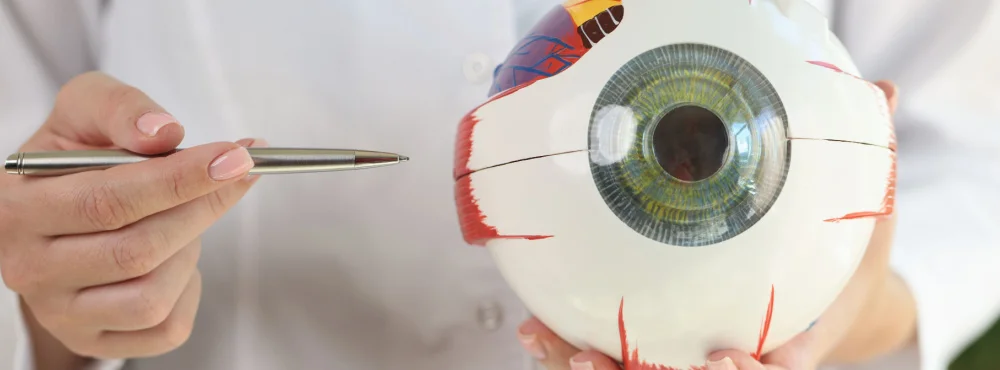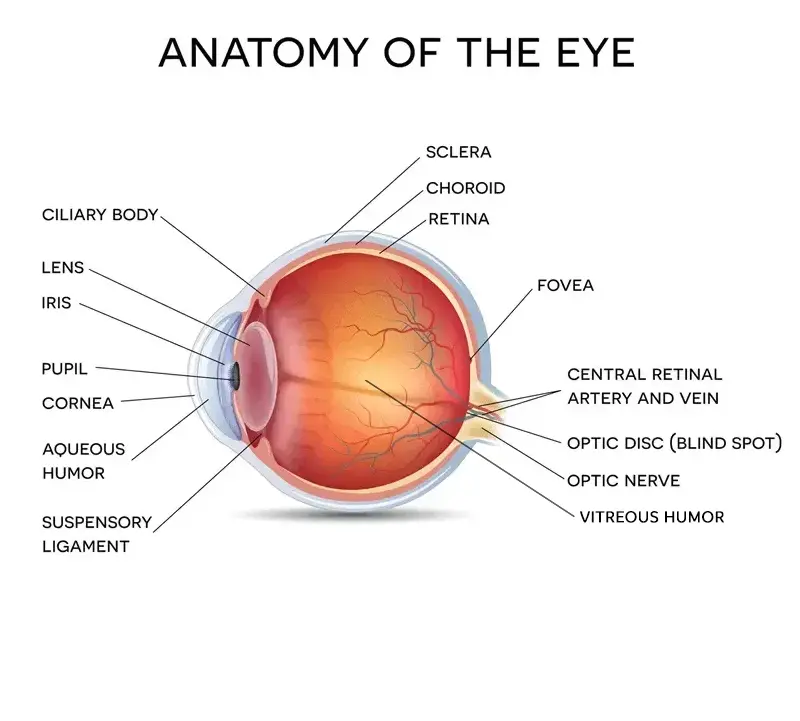
 Offers
Offers-
 Account
Account
-
0
 Favorite
Favorite
-
0
 Basket
Basket



The eye is the organ that helps us see. It features several components which work in conjunction to give us sight. This includes the cornea, iris, pupil, lens, retina, macula, optic nerve, choroid and vitreous.
For a full breakdown of the human eye, read below.
The anatomy of the human eye provides us with the ability to see colour, differentiate between light and dark (light perception) and judge the distance between two objects (depth perception). The components of the human eye are split into different parts that work together to help us see. There are three layers of the human eye:
Each part of the eye performs a different function that contributes to our vision:

Iris – the coloured part of the eye that surrounds the pupil. It regulates the amount of light entering the eye by controlling the size of the pupil.
Pupil – the round centre (within the iris) which light passes through to focus on the retina and begin the process of sight.
Cornea – the clear part at the front of the eye which bends light rays so they can freely pass through the pupil. It also provides a physical barrier against trauma.
Lens – this is located behind the pupil and allows the eyes to focus on small details. Its main function is to transmit and focus light onto the retina.
Macula - this is located in the retina and is a small central area that contains light-sensitive cells which allow us to see in fine detail (20/20 vision).
Optic nerve – this is an extension of the central nervous system (brain and spinal cord). It transmits electrical impulses from your eyes to your brain.
Retina – located at the back of the eye, the retina contains light-sensitive cells. It converts light into chemical and nervous signals. The brain uses these signals to understand what the eye is seeing.
Choroid – this is the middle layer of the eye which is located between the retina and sclera. It contains connective tissues and supplies nutrients to the outer retina.
Ciliary body - this part of the eye connects the choroid to the iris. It produces a fluid called aqueous humor.
Fovea – the fovea (centralis) is responsible for providing the highest visual acuity, producing the sharpest vision and the greatest colour contrast.
Optic disc – also referred to as the ‘blind spot’ or optic nerve head. The optic disc is a circular area at the back of the eye where the optic nerve connects to the retina.
Sclera – the white outer layer of the eye surrounding the cornea. It supports the eyeball and protects it against rupture.
Rod cells – photoreceptor cells located in the retina at the outer edges. These cells can function in low light and are responsible for peripheral vision.
Cone cells – also located in the retina, these light-sensitive cells function best in bright light and are responsible for colour vision.
Vitreous humor – this is a transparent jelly-like substance which fills the eyeball behind the lens.
Aqueous humor – this is a thin, transparent fluid in the front part of the eye which provides nourishment to the cornea and the lens. This is 99.9% water.
The eye is a very complex organ, however, the way it works is often compared to a camera. Here’s the step-by-step process:
1) Light enters the eye through the cornea.
2) The light passes through the pupil and the iris controls the amount (of light) which passes through.
3) Light rays then reach the lens, and the rays begin to convergelens helps the eye focus on objects.
<4) The lens focusses light rays onto the retina which receives an inverted image and converts this into electrical signals.
5) The electrical signals are transmitted by the optic nerve to the visual cortex (the part of the brain which controls sight).
In addition to the anatomy of the eye, there are six extraocular muscles which control eye movement:
Additionally, there are different types of eye movements which are controlled by the six muscles in the eye. This includes: